June 14, 2025 | 13:53 GMT +7
June 14, 2025 | 13:53 GMT +7
Hotline: 0913.378.918
June 14, 2025 | 13:53 GMT +7
Hotline: 0913.378.918
Editor’s note: Despite facing many difficulties and challenges, Son La's agriculture has achieved significant progress over the past decade, following the implementation of the Party Congress Resolution on agriculture. This series of articles provides insights into the lands and the people who have contributed to what many call the "Son La agricultural phenomenon."
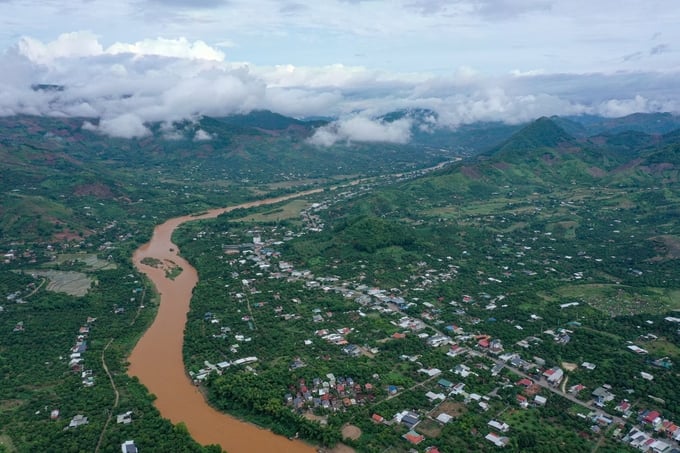
Center of Song Ma district, Son La province. Photo: Tung Dinh.
We visited Song Ma district (named after the Ma River), a highland border district of Son La province, just as the Steering Committee 598 summarized its activities for the first six months of 2024 regarding the production, processing, consumption, and export of agricultural products. Nguyen Thanh Cong, Vice Chairman of the People's Committee of Son La province, explained that Song Ma was chosen for the preliminary review because it has seen the most significant transformation in crop structure policy on Son La's sloped lands over the past decade. These ten years of effort, sparked by the Resolution of the Son La Provincial Party Congress for the 2015-2021 term, have created what is often referred to as the "Son La phenomenon."
Vice Chairman Nguyen Thanh Cong provided an overview of the current state of Son La's agriculture: Over 82,000 hectares of fruit trees, with exports exceeding 12,200 tons this year, generating more than 81 million USD. More than 20,000 hectares of coffee and tea, with exports exceeding 16,900 tons, generating 53.9 million USD. Additionally, industrial crops like tea, cassava, and others have brought hundreds of millions of dollars to the people of Son La in recent years.
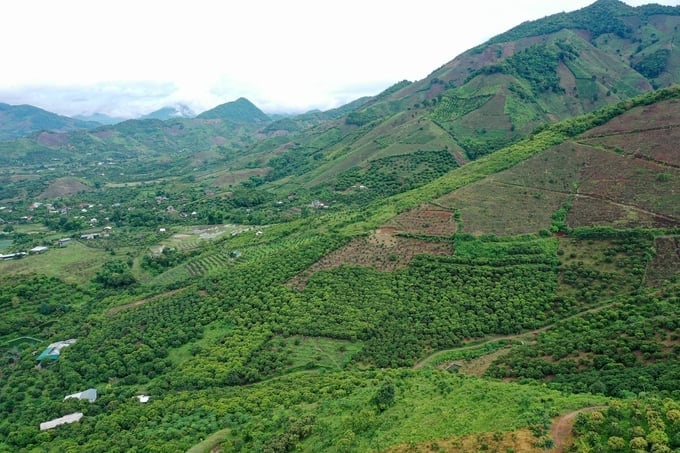
Revolution on sloping land. Photo: Tung Dinh.
From the Ma River to Mai Son, from the Moc Chau Plateau to the Na San Plateau, then Yen Chau, Thuan Chau, Quynh Nhai, Phu Yen, and Muong La, each region has its unique soil and climate conditions. Through human will and labor, they have gradually transformed into large agricultural areas. For example, there are nearly 20,000 hectares of longan in Song Ma, Mai Son, and Thuan Chau, producing nearly 80,000 tons annually. There are more than 12,400 hectares of plums in Moc Chau, Yen Chau, and Van Ho; more than 19,692 hectares of mangoes; and significant areas dedicated to custard apples, bananas, strawberries, and passion fruits.
The agricultural restructuring revolution has left no mountain, field, or ravine idle under the diligent hands of the Thai, Kinh, Mong, and Kho Mu people. This ongoing effort has transformed Son La into the agricultural capital of the Northwest and a significant contributor to the nation's agriculture.
Like the Ma River land stretching along the Vietnam-Laos border, with the river of the same name running alongside the border mountains. The area is adorned with deep green forests. You have the Ma River, and I have Muong Hung Mountain, both referenced in the song "Northwest Love Song," which is set in this very land. On this cool morning, that song echoed through the green trees. The greenery from the banks of the Ma River climbs up to the high hills of Muong Hung Mountain, mingling with the white clouds atop the mountains.

Fruit tree plantation along the Ma River. Photo: Tung Dinh.
According to Nguyen Tien Hai, Vice Chairman of the District People's Committee, the district's longan area is approximately 8,000 hectares, nearly double that of Hung Yen province, the original home of Song Ma longan. "After a decade of climbing hills, Song Ma has transformed from a poor highland district into a leading region in developing raw material areas and commodity agriculture in Son La," the Vice Chairman of Song Ma district said excitedly.
Leaving the district center, we traveled along the riverbank, passing through various communes, each marked by its fruit tree areas. The Chieng Khuong longan region, the Na Nghiu plum region, the mango region in Muong Hung, and the black summer grapes in Muong Cai all painted a continuous expanse of green that seemed to stretch endlessly. Thai-roofed and Japanese-roofed houses appeared among peaceful, prosperous villages. Village names such as Quyet Tien, Quyet Thang, and Canh Kien stand as reminders of a new economic era when people from both mountainous and lowland areas came together to reclaim land for farms and forestry, collectively creating the current vibrant landscape along the Ma River.
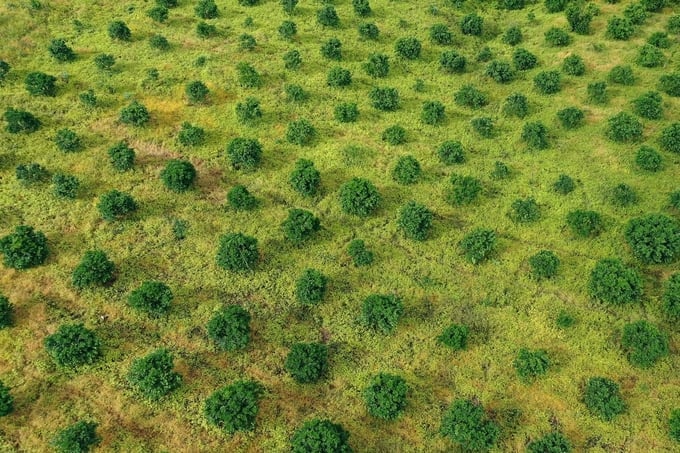
Beautiful bonsai-like fruit trees in the Song Ma district. Photo: Tung Dinh.
As we admired the Ma River, Mr. Hai's voice softened unexpectedly. The Vice Chairman of the district began recounting this land's not-so-distant past. Just over ten years ago, Mr. Hai compared the conditions of that time to now, describing the difference as vast as heaven and earth.
In those years, when the Government implemented policies for afforestation and developing livelihoods for the border highlands, Song Ma emerged as a pioneer due to its numerous agricultural and forestry enterprises. Various plants were tested, but only the longan tree introduced by people from Hung Yen and the red lac tree, planted extensively for resin, proved successful. "Every transformation is a revolution," Mr. Hai remarked. The first revolution occurred around 2010, when the Fruit and Vegetable Research Institute launched a grafting project to improve fruit trees along the Ma River. At that time, the Vice Chairman of the District People's Committee was also the Head of the Agricultural Extension Station, and he mobilized farmers daily to cut down old longan trees planted in the 1960s to enhance productivity.
Despite his persistent efforts, only a few families initially agreed. The first renovation graft model was implemented by Mr. Nguyen Van Ba's family in Quyet Tien village, Na Nghiu commune. When the saw blade cut down the nearly 50-year-old longan tree, Mr. Ba's mother silently sat and cried. To her, the trees seemed intertwined with her fate, especially the longan tree from their ancestral homeland. It was part of their journey of leaving their home to start anew, enduring extremely difficult times. Seeing the tree cut down with a single saw blade was heartbreaking and hard to accept. Fortunately, this revolution succeeded. The Hung Yen longan roots were grafted with T6 longan varieties. Within just two years, the trees began to bear fruit. By the third year, they yielded abundantly, generating up to 900 million VND per hectare, the highest in Son La province at that time.

Chieng Khuong longan. Photo: Tung Dinh.
By 2015, following the Party Congress, Son La implemented a resolution to change the structure of crops on sloping land. The Ma River region quickly became a key fruit-growing area in the province, with approximately 11,000 hectares producing nearly 50,000 tons annually, surpassing the plans and goals set by the congress. Currently, in addition to nearly 8,000 hectares of longan, this border highland district also cultivates 1,820 hectares of mangoes, 312 hectares of bananas, 112 hectares of plums, 117 hectares of pineapples, and 160 hectares of grapefruits. Other crops such as cassava, sweet corn, and duckweed also contribute to a large raw material area that supports Son La province's agricultural restructuring policy.
Preliminary statistics show that the entire Song Ma district has more than 3,000 longan drying kilns. In addition to processing local produce, they also import longan from Muong La, Mai Son, Yen Chau, and other areas. Each drying season processes more than 40,000 tons, and by 2023, nearly 4,000 tons of dried longan from Song Ma were shipped to both domestic and international markets. The longan drying job here now earns workers from 300,000 to 400,000 VND per day, eliminating the need to seek employment elsewhere.
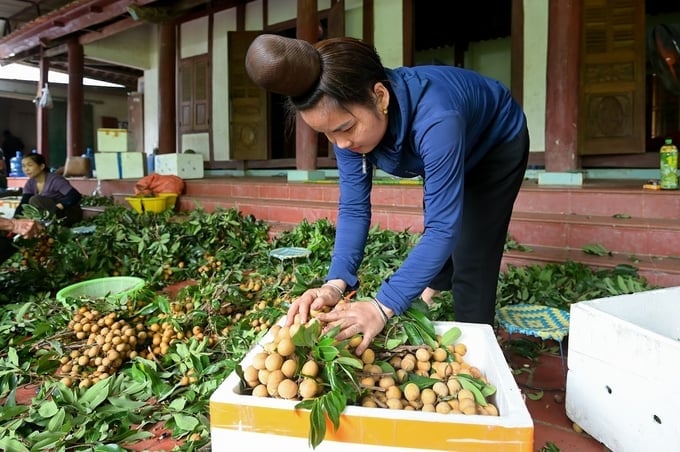
Early longan season in Chieng Khuong. Photo: Tung Dinh.
In the first six months of 2024, the Song Ma district granted the right to use the "Song Ma label" brand to 25 more cooperatives in the area. They are building brands for pineapple, mango, and dragon fruit while partnering with businesses such as Doveco and Minh Khai Lao Cai. This collaboration aims to both develop raw material areas and find export markets.
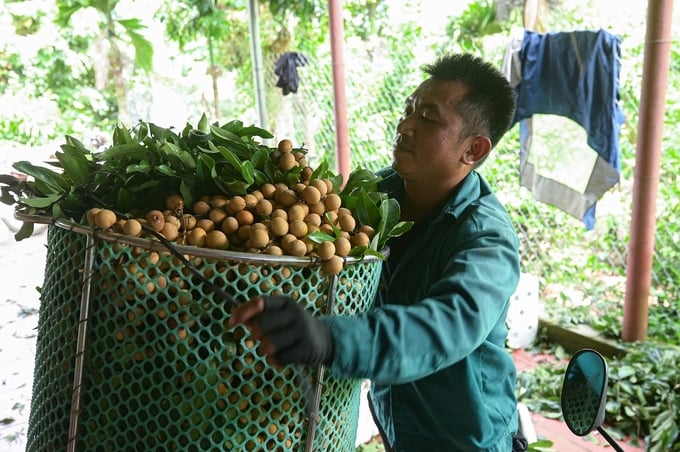
Let the Song Ma brand fly high. Photo: Tung Dinh.
"Up to this point, Song Ma has signed a contract to supply raw materials for the 169-hectare Doveco Son La factory, including 102 hectares of pineapple, 25 hectares of sweet corn, and 41 hectares of spinach. Also, in the first six months of the year, Doveco Son La purchased 520 tons of mangoes for processing and export to the Russian and Japanese markets and purchased 84 tons of pineapples for processing into juice. Song Ma's policy now focuses on intensifying existing fruit tree areas, introducing new plant varieties to diversify products, applying scientific and technical advances, and promoting links with businesses. With the potential, advantages, and production level of the people, if the market remains stable, the fruit capital of Son La province will become increasingly prosperous and strong," shared the Vice Chairman of Song Ma District People's Committee.
As we left the Ma River during the early ripening longan season, we passed prosperous villages with fruit trees laden with branches along both sides of the road. These seem to be the sweet fruits of more than 10 years of Song Ma climbing hills.
Translated by Quynh Chi
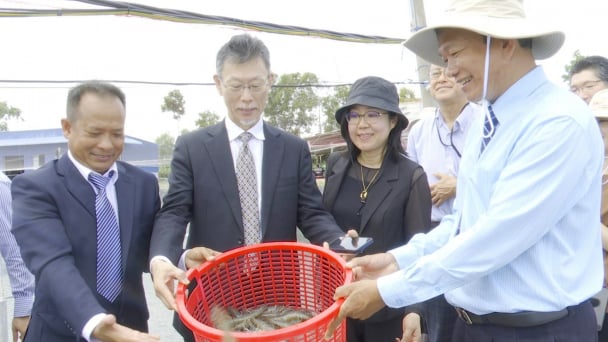
(VAN) In Tien Giang, a high-tech shrimp farm has developed a distinctive energy-saving farming model that has yielded promising results.
![Turning wind and rain into action: [3] 300.000 farmers benefit from agro-climatic bulletins](https://t.ex-cdn.com/nongnghiepmoitruong.vn/608w/files/news/2025/06/12/e5a48259d6a262fc3bb3-nongnghiep-125122.jpg)
(VAN) The agro-climatic bulletin has become a valuable tool for farmers in the Mekong Delta. After more than five years of implementation, the initiative is gradually being expanded nationwide.
![Turning wind and rain into action: [2] Providing forecasts to the people](https://t.ex-cdn.com/nongnghiepmoitruong.vn/608w/files/news/2025/06/12/e5a48259d6a262fc3bb3-nongnghiep-103927.jpg)
(VAN) In addition to improving the quality of hydrometeorological forecasts, putting forecast bulletins into practical use is crucial for production and disaster prevention.
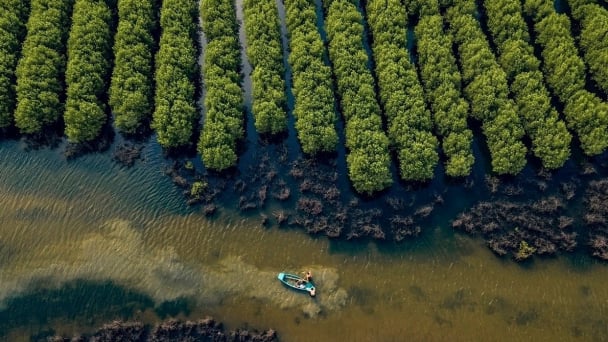
(VAN) Blue carbon is receiving attention for its rapid absorption capacity and vast potential. It represents a promising nature-based solution to respond to climate change.
/2025/06/11/3507-1-161904_583.jpg)
(VAN) Seagrass beds and coral reefs serve as 'cradles' that nurture life in the ocean depths, creating rich aquatic resources in Vietnamese waters.
![Turning wind and rain into action: [1] Forecasting for farmers](https://t.ex-cdn.com/nongnghiepmoitruong.vn/608w/files/news/2025/06/11/e5a48259d6a262fc3bb3-nongnghiep-111919.jpg)
(VAN) Weather is no longer just a matter of fate. Forecasts have now become an essential companion for farmers in every crop season.
/2025/06/10/2501-3-082025_983.jpg)
(VAN) Mr. Le Hoang Minh, Head of Vinamilk's Net Zero project, recently shared insights on the integration of production, energy, and technology in Vinamilk’s green transition journey.